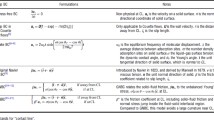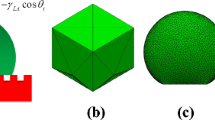Abstract
3D droplet models are developed to numerically investigate the droplet stability and hysteresis of the three-phase contact line on both horizontal and inclined microgrooved solid surfaces. A numerical method is applied to study the shapes and energies of liquid droplets, with a particular focus on the stability of the suspended wetting state. A normalized form of droplet energy is used to compare the relative stabilities of multiple metastable wetting states and a numerical approach is found to reliably predict the wetting stability of droplets on horizontal microgrooved substrates. For wetting on inclined surfaces, numerical simulations of sliding behavior of liquid droplets on flat and periodic microgrooved surfaces with a range of groove geometry are conducted. A numerical model capable of predicting the critical sliding angle of the drop from the knowledge of advancing and receding angles is developed. The effects of microgroove topography, droplet size, and inclination angle on the droplet dynamic behavior are analyzed. Droplet shape and critical sliding angle, obtained from the numerical models, are compared with those of experimental results and are found to be in very good agreement.

Graphical abstract












Similar content being viewed by others
References
Choi CH, Lee H, Weitz DA (2018) Rapid patterning of PDMS microfluidic device wettability using syringe-vacuum-induced segmented flow in non-planar geometry. ACS Appl Mater Interfaces 10(4):3170–3174
Zhu L, Ge JR, Qi YY, Chen Q, Hua RM, Luo F, Chen PR (2018) Droplet impingement behavior analysis on the leaf surface of Shu-ChaZao under different pesticide formulations. Comput Electron Agric 144:16–25
Liang Y, Ju J, Deng N, Zhou X, Yan J, Kang W, Cheng B (2018) Super-hydrophobic self-cleaning bead-like SiO2@ PTFE nanofiber membranes for waterproof-breathable applications. Appl Surf Sci 442:54–64
Lv C, Hao P, Yao Z, Niu F (2015) Departure of condensation droplets on superhydrophobic surfaces. Langmuir 31(8):2414–2420
Rahman MA, Jacobi AM (2012). Study of the effects of microgroove geometry on frost structure and properties. International Refrigeration and Air Conditioning Conference at Purdue, West Lafayette, Indiana, USA, 2294
Extrand CW (2004) Criteria for ultralyophobic surfaces. Langmuir 20(12):5013–5018
Farhat N, Alen SK, Rahman MA (2015) Numerical study of the wetting and mobility of liquid droplets on horizontal and inclined flat and microgrooved surfaces. Procedia Eng 105:576–585
Callies M, Quéré D (2005) On water repellency. Soft Matter 1(1):55
Rahman MA, Jacobi AM (2012) Wetting behavior and drainage of water droplets on microgrooved brass surfaces. Langmuir 28(37):13441–13451
Patankar NA (2003) On the modeling of hydrophobic contact angles on rough surfaces. Langmuir 19(4):1249–1253
Cao L, Hu HH, Gao D (2007) Design and fabrication of micro-textures for inducing a superhydrophobic behavior on hydrophilic materials. Langmuir 23(8):4310–4314
Extrand CW (2002) Model for contact angles and hysteresis on rough and ultraphobic surfaces. Langmuir 18(21):7991–7999
Rahman MA, Jacobi AM (2012) Drainage of frost melt water from vertical brass surfaces with parallel microgrooves. Int J Heat Mass Transf 55(5–6):1596–1605
Cassie ABD, Baxter S (1944) Wettability of porous surfaces. Trans Faraday Soc 40:546–551
Wenzel RN (1936) Resistance of solid surfaces to wetting by water. Ind Eng Chem 28(8):988–994
Rahman MA, Goswami A (2017) Analysis of the energetics and stability of liquid droplets on textures surfaces with square micropillars. 13th International Conference on Heat Transfer, Fluid Mechanics and Thermodynamics, Portoroz, Slovenia
Reyssat M, Yeomans JM, Quéré D (2007) Impalement of fakir drops. EPL 81(2):26006
Kusumaatmaja H, Blow ML, Dupuis A, Yeomans JM (2008) The collapse transition on superhydrophobic surfaces. EPL 81(3):36003
Bormashenko E (2015) Progress in understanding wetting transitions on rough surfaces. Adv Colloid Interf Sci 222:92–103
Checco A, Ocko BM, Rahman A, Black CT, Tasinkevych M, Giacomello A, Dietrich S (2014) Collapse and reversibility of the superhydrophobic state on nanotextured surfaces. Phys Rev Lett 112(21):216101
Nosonovsky M, Bhushan B (2007) Biomimetic superhydrophobic surfaces: multiscale approach. Nano Lett 7(9):2633–2637
Afferrante L, Carbone G (2010) Microstructured superhydrorepellent surfaces: effect of drop pressure on fakir-state stability and apparent contact angles. J Phys Condens Matter 22(32):325107
Barbieri L, Wagner E, Hoffmann P (2007) Water wetting transition parameters of perfluorinated substrates with periodically distributed flat-top microscale obstacles. Langmuir 23(4):1723–1734
Zheng QS, Yu Y, Zhao ZH (2005) Effects of hydraulic pressure on the stability and transition of wetting modes of superhydrophobic surfaces. Langmuir 21(26):12207–12212
Cai TM, Jia ZH, Yang HN, Wang G (2016) Investigation of Cassie-Wenzel wetting transitions on microstructured surfaces. Colloid Polym Sci 294(5):833–840
Fang W, Guo H, Li B, Li Q, Feng X (2018) Revisiting the critical condition for the Cassie–Wenzel transition on micropillar-structured surfaces. Langmuir 34(13):3838–3844
Bhushan B, Jung YC (2011) Natural and biomimetic artificial surfaces for superhydrophobicity, self-cleaning, low adhesion, and drag reduction. Prog Mater Sci 56(1):1–108
Dubov AL, Perez-Toralla K, Letailleur A, Barthel E, Teisseire J (2013) Superhydrophobic silica surfaces: fabrication and stability. J Micromech Microeng 23(12):125013
He B, Patankar NA, Lee J (2003) Multiple equilibrium droplet shapes and design criterion for rough hydrophobic surfaces. Langmuir 19(12):4999–5003
Dubov AL, Mourran A, Möller M, Vinogradova OI (2015) Regimes of wetting transitions on superhydrophobic textures conditioned by energy of receding contact lines. Appl Phys Lett 106(24):241601
Bottiglione F, Di Mundo R, Soria L, Carbone G (2015) Wenzel to Cassie transition in superhydrophobic randomly rough surfaces. Nanosci Nanotechnol Lett 7(1):74–78
Zhang X, Zhu W, He G, Zhang P, Zhang Z, Parkin IP (2016) Flexible and mechanically robust superhydrophobic silicone surfaces with stable Cassie–Baxter state. J Mater Chem A 4(37):14180–14186
Long J, Pan L, Fan P, Gong D, Jiang D, Zhang H et al (2016) Cassie-state stability of metallic superhydrophobic surfaces with various micro/nanostructures produced by a femtosecond laser. Langmuir 32(4):1065–1072
Wang G, Jia ZH, Yang HN (2016) Stability of a water droplet on micropillared hydrophobic surfaces. Colloid Polym Sci 294(5):851–858
Guo HY, Li B, Feng XQ (2016) Stability of Cassie-Baxter wetting states on microstructured surfaces. Phys Rev E 94(4):042801
Zu YQ, Yan YY (2016) Single droplet on micro square-post patterned surfaces-theoretical model and numerical simulation. Sci Rep 6:19281
Pashos G, Kokkoris G, Papathanasiou AG, Boudouvis AG (2016) Wetting transitions on patterned surfaces with diffuse interaction potentials embedded in a Young-Laplace formulation. J Chem Phys 144(3):034105
Chen Y, He B, Lee J, Patankar NA (2005) Anisotropy in the wetting of rough surfaces. J Colloid Interface Sci 281(2):458–464
Gong W, Zu Y, Chen S, Yan Y (2017) Wetting transition energy curves for a droplet on a square-post patterned surface. Sci Bull 62(2):136–142
Hao JH, Wang ZJ (2016) Modeling Cassie-Baxter state on superhydrophobic surfaces. J Dispers Sci Technol 37(8):1208–1213
Zhang W, Zhang RR, Jiang CG, Wu CW (2017) Effect of pillar height on the wettability of micro-textured surface: volume-of-fluid simulations. Int J Adhes Adhes 74:64–69
Chatain D, Lewis D, Baland JP, Carter WC (2006) Numerical analysis of the shapes and energies of droplets on micropatterned substrates. Langmuir 22(9):4237–4243
Promraksa A, Chuang YC, Chen LJ (2014) Study on the wetting transition of a liquid droplet sitting on a square-array cosine wave-like patterned surface. J Colloid Interface Sci 418:8–19
Goswami A, Rahman MA (2017) Numerical study of energetics and wetting stability of liquid droplets on microtextured surfaces. Colloid Polym Sci 295(10):1787–1796
Semprebon C, Herrmann C, Liu B-Y, Seemann R, Brinkmann M (2018) Shape evolution of droplets growing on linear microgrooves. Langmuir 34(36):10498–10511
He L, Sui X, Liang W, Wang Z, Akbarzadeh A (2018) Numerical analysis of anisotropic wetting of chemically striped surfaces. RSC Adv 8(55):31735–31744
Brakke KA (1992) The surface evolver. Exp Math 1(2):141–165
Janardan N, Panchagnula MV (2014) Effect of the initial conditions on the onset of motion in sessile drops on tilted plates. Colloids Surf A Physicochem Eng Asp 456:238–245
Semprebon C, Brinkmann M (2014) On the onset of motion of sliding drops. Soft Matter 10(18):3325–3334
Extrand CW, Kumagai Y (1995) Liquid drops on an inclined plane: the relation between contact angles, drop shape, and retentive force. J Colloid Interface Sci 170(2):515–521
Gao N, Geyer F, Pilat DW, Wooh S, Vollmer D, Butt H-J, Berger R (2018) How drops start sliding over solid surfaces. Nat Phys 14:191–196
Antonini C, Carmona FJ, Pierce E, Marengo M, Amirfazli A (2009) General methodology for evaluating the adhesion force of drops and bubbles on solid surfaces. Langmuir 25:6143–6154
Santos MJ, White JA (2011) Theory and simulation of angular hysteresis on planar surfaces. Langmuir 27(24):14868–14875
Santos MJ, Velasco S, White JA (2012) Simulation analysis of contact angles and retention forces of liquid drops on inclined surfaces. Langmuir 28(32):11819–11826
Lv C, Yang C, Hao P, He F, Zheng Q (2010) Sliding of water droplets on microstructured hydrophobic surfaces. Langmuir 26(11):8704–8708
Qi B, Zhou J, Wei J, Li X (2018) Study on the wettability and condensation heat transfer of sine-shaped micro-grooved surfaces. Exp Thermal Fluid Sci 90:28–36
ElSherbini AI, Jacobi AM (2004) Liquid drops on vertical and inclined surfaces: I. An experimental study of drop geometry. J Colloid Interface Sci 273(2):556–565
Bhutani G, Muralidhar K, Khandekar S (2013) Determination of apparent contact angle and shape of a static pendant drop on a physically textured inclined surface. Interfacial Phenom Heat Transf 1(1):29–49
Dai X, Sun N, Nielsen SO, Stogin BB, Wang J, Yang S, Wong TS (2018) Hydrophilic directional slippery rough surfaces for water harvesting. Sci Adv 4(3):eaaq0919
Xu B, Yuan Z, Wu Y (2014) Simulation analysis on surface morphology and hysteresis characteristics of molten Sn–3.0 Ag–0.5 Cu sitting on the inclined Ni substrate. Colloids Surf A Physicochem Eng Asp 441:217–225
Qiao S, Li Q, Feng X (2018) Sliding friction and contact angle hysteresis of droplets on microhole-structured surfaces. Eur Phys J E 41(2):25
Qiao S, Li S, Li Q, Li B, Liu K, Feng X (2017) Friction of droplets sliding on microstructured superhydrophobic surfaces. Langmuir 33(47):13480–13489
Alen SK, Farhat N, Rahman MA (2016) Analytical modeling of wetting states and simulation of drop shape on microstructured surfaces. AIP Conf Proc 1754:050043
Author information
Authors and Affiliations
Corresponding author
Ethics declarations
Conflict of interest
The authors declare that they have no conflict of interest.
Additional information
Publisher’s note
Springer Nature remains neutral with regard to jurisdictional claims in published maps and institutional affiliations.
Rights and permissions
About this article
Cite this article
Goswami, A., Alen, S.K., Farhat, N. et al. Numerical study of wetting stability and sliding behavior of liquid droplets on microgrooved surfaces. Colloid Polym Sci 297, 989–1000 (2019). https://doi.org/10.1007/s00396-019-04527-0
Received:
Revised:
Accepted:
Published:
Issue Date:
DOI: https://doi.org/10.1007/s00396-019-04527-0




